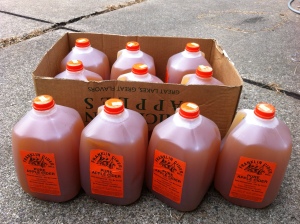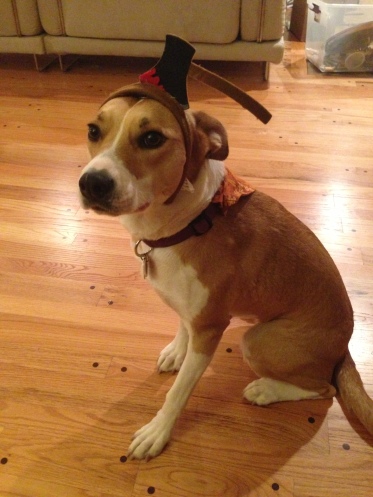Hello, everyone! As some of you may know, Julie’s working on her “30 by 30” list. For those of you aren’t familiar with this, she came up with a list of 30 things she wanted to do by the time she turned 30. One item on her list included having a guest blogger. That’s where I (her husband, Dave) come in.
I don’t know the first thing about sewing, quilting, cooking, etc. The closest I get to Julie’s craftiness is probably through brewing and winemaking. Along those lines, Julie and I have recently taken an interest in trying our hand at making homemade hard cider. I’ll use this opportunity to share some information about our first attempt and how anyone can make hard cider at home.
First things first, equipment / ingredients:
Cider! (unpasteurized from a local cider mill is suggested)
A stock pot (slightly larger than your volume of hard cider that you want to make)
Wine tannin
Pectic enzyme
Cider yeast
Sanitizer (StarSan or Iodophor, for example)
Fermentation bucket with lid
Racking cane w/ tubing
Airlock
Potassium metabisulfite
Bottling bucket with spigot
Bottle filler
Bottles
Bottle caps
Bottle capper
Making hard cider is relatively simple process. Julie and I decided to do a 10 gallon batch, but you can scale the amount to whatever is preferred. You’ll want to use cider without any preservatives, since any preservatives will inhibit or prevent the cider’s ability to ferment into hard cider. We used fresh, unpasteurized cider from our local cider mill.
One of the key things to keep in mind when you’re fermenting beer/wine/cider, is that bacteria is usually your biggest enemy. Fermentation works by creating an environment in which yeast can consume sugars and undergo a process that results in alcohol being produced. While making an ideal environment for your yeast, you also make an ideal environment for other bacteria to thrive. Bacteria can easily add off flavors to your cider, or ruin it completely.
To kill off any nasties in the unpasteurized cider, we pasteurized the cider by heating it to 170F for 45 minutes in a large brewing pot. Any stock pot will work just fine. In addition to killing off any bacteria, this process will also kill any wild yeast. There are all types of natural yeasts found with any fruit, and each yeast strain will contribute a different flavor profile when allowed to ferment. Wild yeasts could potentially create a wonderful product, or they could be horrible. We chose to kill off any wild yeast so that we could later add our own specially selected yeast strain that is known to produce excellent cider. I feel that cider is too expensive to gamble on wild yeast working out.
In the last 5 minutes on the heat, we added pectic enzyme, and wine tannin. Pectic enzyme is mainly used to break down pectin to produce a nice, clear looking cider. Wine tannin is used to add a bit of tartness/complexity and will aid in the stability and preservation of your cider. Pectic enzyme is often added in amounts of 1 tsp per 5 gallons, but follow the directions of the package if available. Somewhere between ⅛ tsp and ¼ tsp of wine tannin per gallon should be in a reasonable range depending on the desired tartness.
After pasteurization, it’s especially important that anything that comes in contact with the cider is both clean and sanitized to prevent infection. I recommend using StarSan to sanitize equipment, which is a product available at any local homebrew shop or online.
Now that the cider is pasteurized and the additives are in, you’ll want to bring the cider down to around 68F for fermentation. An easy way to bring the temperature down is to create an ice bath. This involves filling a sink with ice water, putting a sanitized lid over your pot, and letting the pot rest in the water. Remember if you want to stir a little to cool the cider down faster, or use a thermometer to take a temperature reading, that that equipment should be sanitized!
Once cooled, you’ll want to pour the cider into a sanitized vessel that you can use to ferment in. A plastic fermentation bucket with a lid, 20%+ larger than your cider volume, works great. 7.9 gallon buckets are commonly available at homebrew shops and work well for a 5 or 6 gallon batch.
At this point, you’re ready to add the yeast! Open up a package of your yeast of choice (we used Lalvin EC-1118) and sprinkle it over the top of the cider. Fermentation buckets generally come with a lid that have a small hole drilled so that you can insert an airlock. The airlock allows the CO2 produced by the yeast to be released, while keeping oxygen out. Put the sanitized bucket lid and airlock on the bucket. The airlock should be filled halfway with either StarSan or a cheap alcohol like vodka.
It’s best to leave the cider to ferment in an area that’s as close to 68F as possible. At this point, simply let the bucket sit for four weeks to let the yeast work its magic! You should start to notice the first signs of fermentation (a bubbling airlock) in 12-48 hours after adding the yeast.
Once fermentation is done, you’ll want to used a sanitized racking cane to siphon the cider into a clean/sanitized bottling bucket. Hard cider can be very dry and tart by default, and it often helps to “backsweeten” by adding sugars to sweeten it up a bit. Adding honey or brown sugar to taste is a common practice.
If you add more sugars, fermentation could start up again, which you don’t want, so it’s good to add potassium sorbate (in amounts on label) to halt any further fermentation. It’s probably good to add the potassium sorbate even if you don’t add more sugars just to be sure no fermentation takes place once your cider is bottled. Fermenting cider in bottles can result in dangerous bottle bombs as CO2 pressure increases! It’s also good to add potassium metabisulfite at this point to better preserve the cider. This process will create a still / non-sparkling cider.
Sanitize enough bottles and caps for your volume of cider. Fill your bottles using your bottle filler and then put on the caps with your bottle capper. At this point, your cider is done and bottled! The hardest part now is waiting. Young cider can taste outright horrible at first, with strong sulfur smells. This is normal! The most important advice I can give you at this point is to not pour it out and to simply wait for it to mature. The character of the cider will drastically improve if you let it sit in the bottle for an extended period of the time. You’ll want to age the cider for six months to a year.
Enjoy!








































